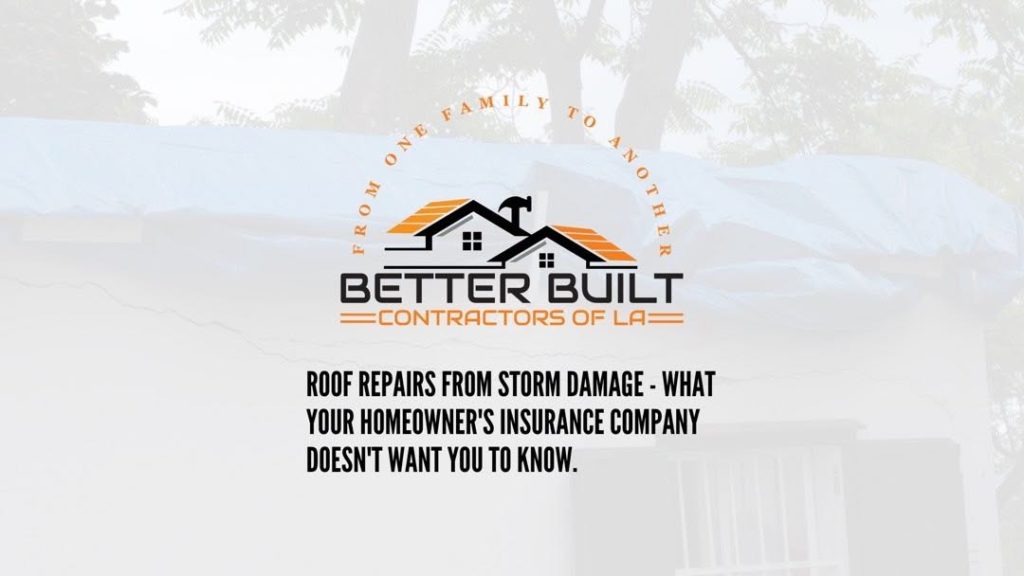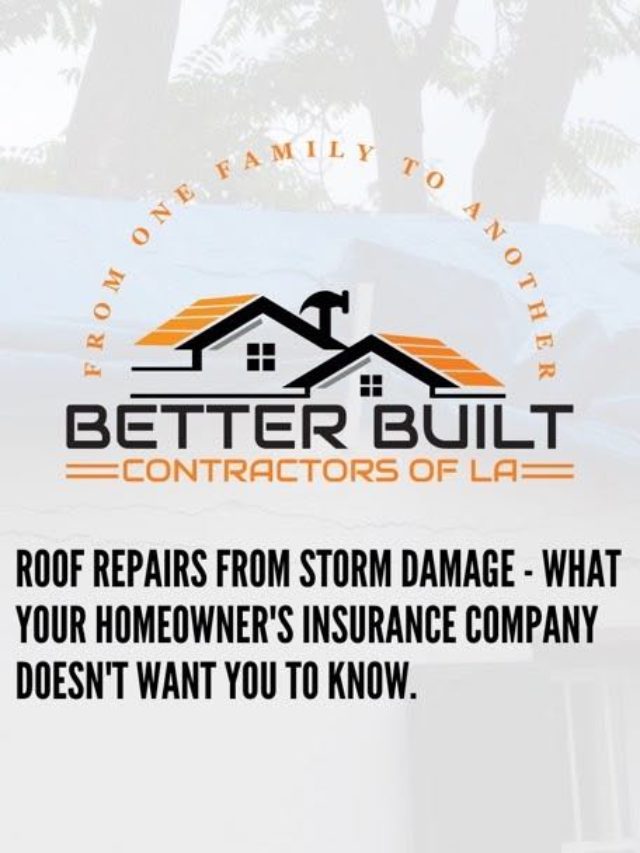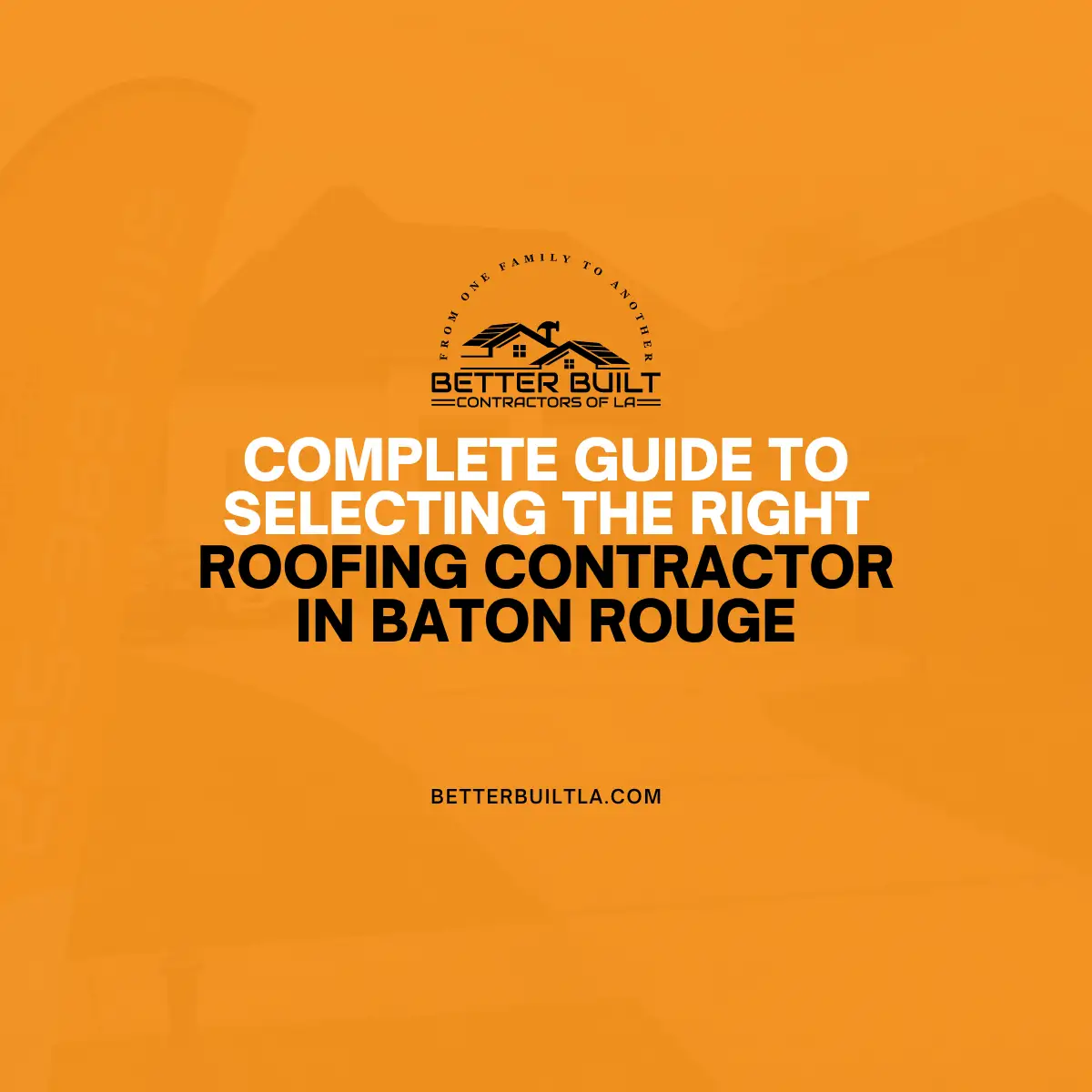Have you ever wondered what your homeowner’s insurance is going to cover for roof repairs?
Most people don’t know the answer because it all depends on a few factors. If you are in Louisiana, then this post will give you an idea of how much coverage your insurance carrier will provide. Additionally, understanding your insurance coverage goes hand in hand with choosing the right roofing contractor.
What is storm damage to roofs, and what does it mean for homeowners?
A storm is a weather event that can produce hail, high winds, and heavy rainfall.
These events often cause roof damages to the home and will need to be repaired if they are not fixed quickly, these repairs could lead homeowners in Louisiana into spending thousands of dollars out-of-pocket.
A homeowner’s insurance company will provide coverage to fix roof damages caused by storms, but there are limitations.
Receipts may be required to make temporary repairs.
Keep receipts for any work in progress and consult your insurance policy’s provisions concerning reimbursement or counting money spent towards the deductible.

Other steps to take include:
- Take pictures or videos of every bit of damage, from your home to the furniture inside it.
- When disaster strikes, you must have an accurate contact for your property so the insurance company can send out a claims adjuster.
- Attempt to separate damaged personal property items from undamaged items. This will help the claims adjuster process your claim more effectively and quickly.
Louisiana isn’t limited to Hurricanes. Be sure to read our new blog post to learn how to protect your shingle roof from winter damage.
Hurricane Deductible
Your homeowners’ policy will likely have a hurricane deductible. Your deductible is the amount you must pay out of pocket before your insurance coverage pays for the claim. You will find the amount of your deductible on the declaration page of your policy. It may be called a hurricane, named storm or windstorm, and hail deductible.
Hurricane deductibles typically range anywhere from two to five percent of a home’s total insured value – so if a home is insured for $200,000 and has a five percent deductible, the first $10,000 must be paid out of pocket by the policyholder.
You’ll likely have to contact your agent to determine your insured value and the deductible percentage.
If you’ve been impacted by Hurricane Ida, you’ll want to read our recent post about tips to mitigate roof damage from the storm.
Coverage
Your policy will have a limit on the amount of coverage. Your insurer is not obligated to cover any damage exceeding this limit, so make sure you’re aware of your limits before filing a claim for roof storm damages.
Limits typically range between 50-100% insured value and can go higher or lower depending on your policy.


In Louisiana, most insurance companies will cover windstorm damages up to 100% insured value as long as a hurricane causes them with winds sustained at 73 miles per hour or more (category three) for an entire 12-hour period in one location. It’s not considered “tropical storm strength” because Louisiana has rules that set the minimum thresholds for windstorm damage.
If a storm is less intense or doesn’t last 12 hours, homeowners will have to share responsibility with their insurance company if they want coverage above 50% insured value.
In this case, you’ll need to make up the difference by paying an extra premium – which can add up if you’re trying to cover 100%.
What does Louisiana storm damage insurance cover?
Generally, homeowners’ policies will cover damage from wind and hail but not flooding. For more details, be sure to check out this fantastic resource on the Louisiana Department of Insurance website.
Flooding is covered by separate flood insurance issued as a part of the national flood insurance program.
Learn about the importance of hiring a local roofing contractor who can guide you through the complexities of insurance claims and ensure a smooth process for your roofing needs.
How much coverage will I get?
The amount of roof damage covered is based on your policy’s limits and the size of your deductible. The higher the deductible, the less money you’ll have to pay out-of-pocket after a storm damages your roof – but with that tradeoff comes a higher premium.
How homeowner’s insurance policies cover roof repairs
One of the most common misconceptions people have is that their homeowner’s coverage will pay for all or even most roof repairs. The truth is your insurance carrier may provide some contributions to help with those costs, but it won’t cover everything.
Homeowners insurance typically pays for repairs to your home’s exterior, including the roof. It is essential to recognize what this coverage does not include so you can understand if any of your interior needs are covered as well.


For example, the roof of an unattached structure on your property, such as a shed or detached garage, may be covered by the other structure’s protection in a homeowners insurance policy if the damage is caused by a covered peril.
It’s important to remember that you will likely need to pay a deductible before homeowners insurance helps pay to repair a damaged roof, and your coverage limit will apply. Read your policy to learn your deductible and coverage limits, or contact your agent for help adjusting them to fit your needs.
Note that some homeowners insurance policies may have wind damage and hail exclusions, meaning damage caused by those events is not covered, so you’ll want to clarify with your agent or insurer.
Understanding the intricacies of your insurance coverage and how it applies to roof repairs is just one piece of the puzzle. Another important aspect is considering how to finance the portion of the repair costs not covered by insurance. This is where exploring financing options becomes invaluable. Better Built Contractors has partnered with Hearth to provide simple and straightforward financing options for your roofing projects.
Discover the advantages of this approach in our latest blog post, “Unlocking the Advantages: Financing Your Roofing Project,” which offers insights into how financing can make managing the costs of your roofing needs more manageable and efficient.
Things you should know about roof inspections, including the importance of getting one before a storm hits and what to expect.
Upon the occurrence of a storm, you must have your roof inspected by an expert. If you are unsure when or how to get this done, keep in mind that homeowners insurance companies will require evidence of a recent inspection before they approve payment for repairs – so make sure to contact us now and schedule one!
When a roof inspection is conducted, the inspector will examine all areas of your roof for any signs of damage caused by recent storms. Inspections typically take 30-45 minutes and are done for free.
The person conducting the inspection will look at things like:
- Shingles that have been loosened or blown off
- Wooden roof trusses that have been damaged
- Roof flashing that has come loose or broken
It’s important to identify all damage and report it because if the roof is left unrepaired, water will be able to get inside your home. This could lead to mold growth and structural problems in a short amount of time.
Avoid the urge to pressure wash storm debris off of your roof after the weather event passes. Learn why you shouldn’t use a pressure washer on your roof in our recent post.
If you find that recent storms have damaged your roof, it’s important to contact a professional for repairs as soon as possible.
When your insurer will pay for roof repair costs
Insurers can contribute to roof repairs, but it’s important to understand that they will not cover all costs.
If your insurer does contribute to the cost of repairing damage caused by a storm or weather-related event, you may need to pay out-of-pocket first if there is an applicable deductible on your policy. The amount depends on your insurer and the type of event but typically ranges between two to five percent.
For example, if you live in Louisiana and have a storm deductible on your policy of three percent, that means for every $100 spent repairing roof damage, you will need to pay an additional $30 out-of-pocket before insurance will kick in.
Tips on how to get a quick quote for an estimate on repairing or replacing your home’s damaged roof
If you have a damaged roof, it’s crucial to get a quick quote for the cost of repairing or replacing it. Many factors determine how much your insurance company will offer in financial assistance; there is no way to know this without contacting them first.
Insurance companies typically provide quotes for residential homeowners, but it is important to clarify how much assistance they are willing to provide before you incur any costs.
Contacting your insurer will help you estimate the cost of repairs and get a better idea of what expenses are in store for you.
It’s also important that if your policy has an applicable deductible—such as in Louisiana, where the deductible is three percent—you are prepared to pay this out-of-pocket before your insurer covers any portion of the cost.
If it sounds like roof repairs might be more than what homeowners insurance can offer in financial assistance and you have additional funds available, then consider skipping the waiting period for a payout by using an out-of-pocket expense.


If you need a quote on replacing your roof, get your free quotation today.
How to file a claim with your insurer if there is any evidence of windstorm damage in Louisiana
If a storm damages your roof, filing a claim with your homeowner’s insurance is important.
All you have to do is call or email your agent with the following information:
- The date and time of the incident;
- How much damage was caused by windstorms or other weather conditions;
- A description of any damages.
If your roof has been damaged by recent storms, contact us to schedule an inspection today! We will send a professional trained in residential roofing to do a thorough inspection and give you an accurate estimate of the cost of repairing your roof. We’ll even help you with all of the insurance paperwork.
Ways that homeowners can protect themselves from future storms
If you are lucky enough to make it through a hurricane or other storm without apparent roof damage, it’s important to protect yourself in the future.
There are a few things you can do:
- Check your roof for damage and make sure it’s in good shape. If the storm is strong enough, a small problem can lead to a big one.
- If you have missing or need replacing shingles, replace them before hurricane season starts again!
Frequently Asked Roof Storm Damage Questions
Here are some of the most frequently asked questions we receive about roof storm damage:
What to do before a storm?
We’re glad you asked!
It’s crucial to take proactive measures to safeguard your roof before a storm. The key is to ensure there’s no existing damage and that shingles are in good condition. If you have trees, especially those with dead branches, near your roof, it’s essential to trim them back to prevent potential roof contact. Remember, safety first-only do this if it’s safe, and avoid doing it during the storm. Instead, wait for the storm to pass or do it before the storm arrives!
What should homeowners do after a storm?
After a storm, it’s crucial to take immediate action. The first step is to contact your agent to verify your storm coverage. Next, schedule an inspection with us. We’re available 24/7, so don’t hesitate to reach out for assistance.
What are the signs of roof damage from storms?
There are a few signs that you can look for to determine if your roof has been damaged. The first sign is shingles missing or cracked, possibly due to something as simple as hail from the storm. If there’s any damage, it will need to be repaired before another storm hits. Another sign is when your roof leaks, which can cause water damage in the house. If you notice any leaking or signs of water damage on a ceiling inside your home, contact us as soon as possible so we can get to work and repair it!
What should I do if my roof is damaged?
If your roof is damaged, it needs to be repaired as soon as possible. If you’re waiting on an adjuster and have a hole or severe damage to your home’s roof, cover up the damage with a tarp. But only if you can do so safely, and don’t do it during a hurricane!
Does homeowner’s insurance cover roof leaks?
Homeowner’s insurance may help pay for repairs to leaks caused by covered perils. An example of a covered peril is fire, which can often cause roof damage with accompanying water leaks that a homeowner’s policy may help fund the repair. However, homeowner’s insurance typically does not cover risks you neglected to take care of or were avoidable due to wear and tear. Instead, it generally helps with repairing sudden accidental damage. So, if the problem is too old or results from an unresolved maintenance issue, homeowners insurance won’t help pay for the roof leak or any resulting damages. Read your policy or contact your local agent to learn if your homeowner’s insurance covers roof damage and how much protection it provides.
What if my roof gets damaged and my house floods?
In the event of sudden and internal water damage, policyholders may soon find that their homeowner’s insurance pays for a roof inspection and repairs. The requirements stipulate that the water must not have touched the outside ground at any point. This means a sudden tear in an HVAC system, cracks in pipes, bulging from extreme heat, etc.
Conclusion:
The best way to know if your roof is ready for the next hurricane or weather event is to have it inspected by a professional.
Contact us to schedule an inspection!
If you’re looking for professional roof repairs in Louisiana, contact us at [your company] today! We offer free estimates and will be happy to answer any questions about your insurance coverage as well.
Give us a call or fill out our online request form with the following information so we can get back to you as soon as possible:







